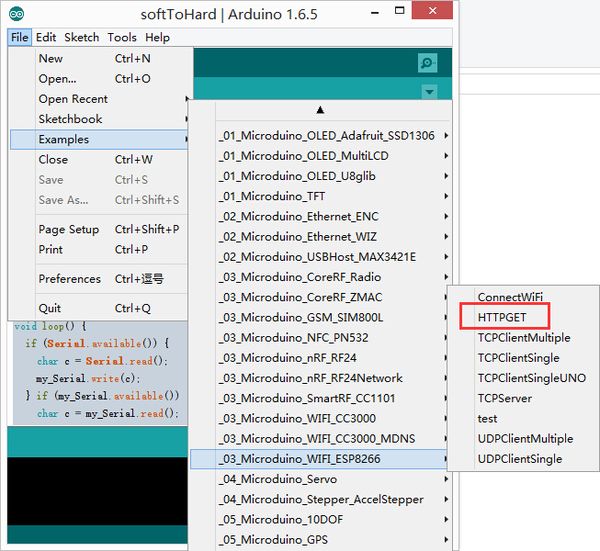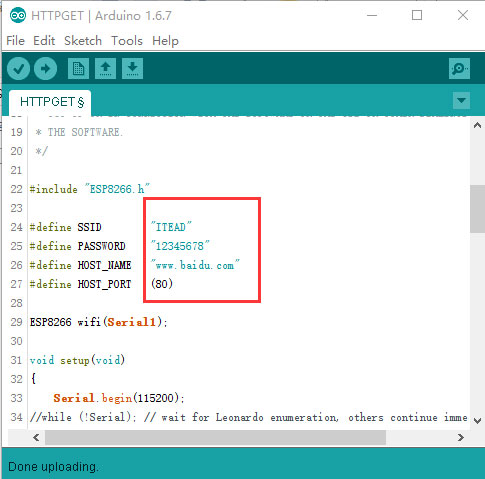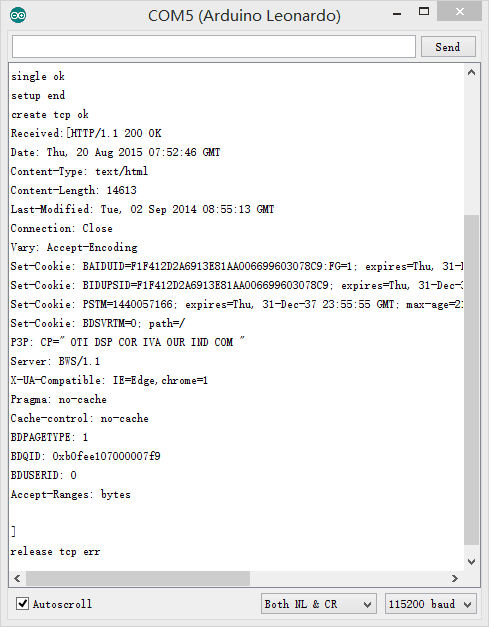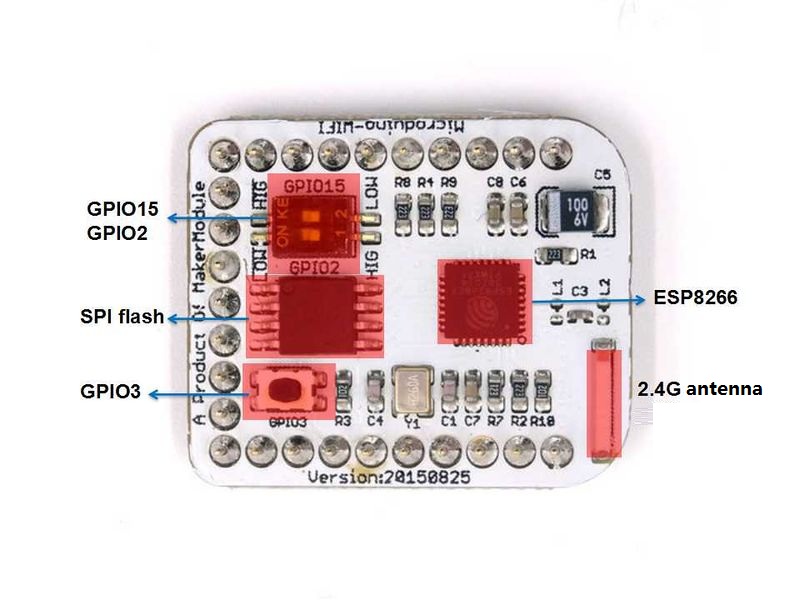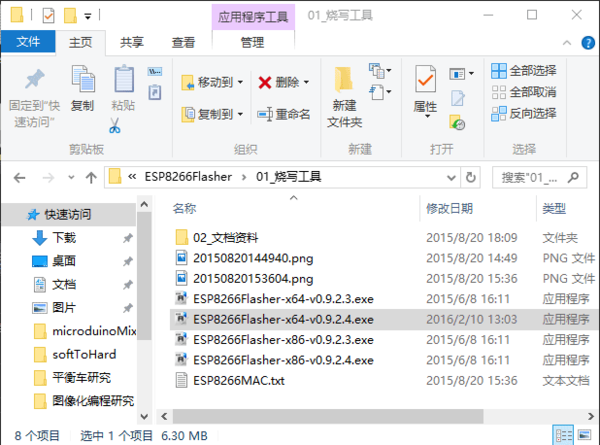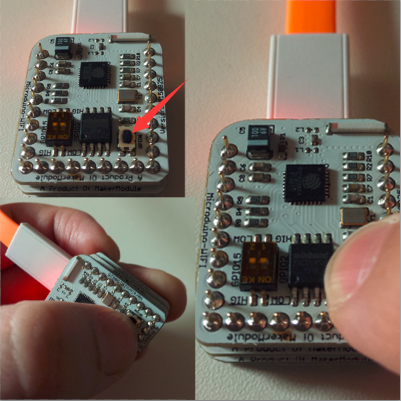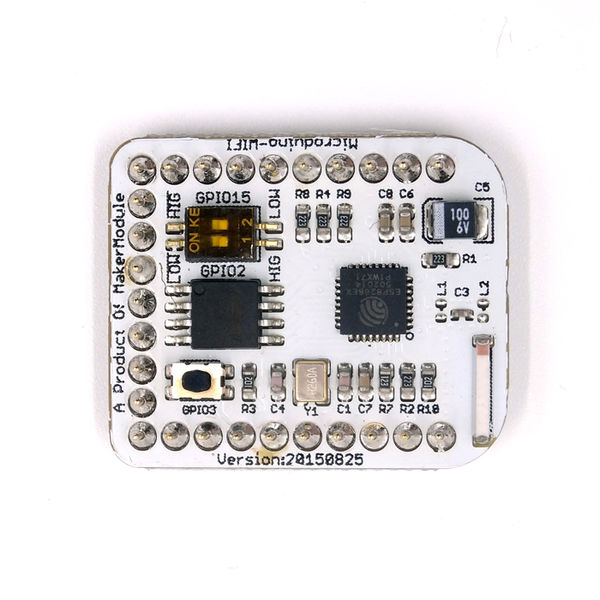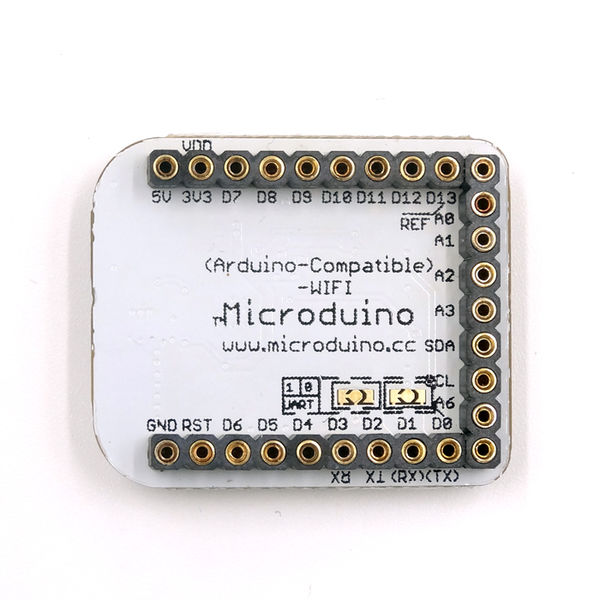Difference between revisions of "Microduino-Module WIFI,ESP"
(→Development) |
|||
| (34 intermediate revisions by 6 users not shown) | |||
| Line 4: | Line 4: | ||
| | | | ||
[[file:Microduino-8266-rect.jpg|400px|thumb|right|Microduino-ESP]] | [[file:Microduino-8266-rect.jpg|400px|thumb|right|Microduino-ESP]] | ||
| − | Microduino- | + | Microduino-WIFI(ESP) is a WIFI communication module, which can communicate with Core+/CoreUSB (Core can not be used, because its baud rate can't reach at 115200.) through the serial port or connect with other WIFI devices and is a complete and system-in-itself wifi network resolution. |
| − | |||
| − | connect other | ||
==Features== | ==Features== | ||
| − | *Serial | + | *Serial communication. |
| − | * | + | *Internet connection available. |
| − | *Small, cheap, stack | + | *Small, cheap, stack-able and open. |
| + | *High on-chip integration. | ||
| + | *Have a strong on-chip processing and storage capabilities. | ||
| + | *Reduce the occupancy of system resources in operation. | ||
| + | *Available for integrating sensor and other application specific devices through the GPIO port. | ||
| − | == | + | ==Specification== |
| − | * | + | *Communication method: Serial pass through with the default serial port D2(RX), D3(TX); |
| − | *Power | + | *Power supply: +3.3VDC 50mA; |
| − | *Status indicator; | + | *Status indicator; |
| + | *SDIO 2.0, SPI and UART interface; | ||
| + | *32-pin QFN sealed ; | ||
| + | *With RF switch, balun, LNA, 24 PA dBm, DCXO and power management unit (PMU) integrated; | ||
| + | *With RISC processor, on-chip memory and external memory interface integrated; | ||
| + | *With MAC/ baseband processor integrated; | ||
| + | *High quality service management; | ||
| + | *With I2S interface required by high fidelity audio applications; | ||
| + | *All internal power supply contains on-chip low dropout linear regulator; | ||
| + | *Proprietary spurious free clock generation architecture; | ||
| + | *With WEP, TKIP, AES, and WAPI engines integrated. | ||
| − | ==Common AT | + | ==Common AT Instruction== |
| − | *All AT | + | *All AT instructions are ended with "\r\n ". When debugging the AT commands, please pay attention to the choice of "\r\n". |
| − | + | *Common AT instruction: | |
| − | + | **AT+RST Restart the module; | |
| − | *Common AT | + | **AT+GMR Check the version information; |
| − | **AT+RST Restart module | + | **AT+CWMODE=3 Station and access point; |
| − | **AT+GMR Check the version information | + | ***1 Station Mode; |
| − | **AT+CWMODE=3 | + | ***2 AP Mode; |
| − | ***1 Station Mode | + | ***3 AP and the Station. |
| − | ***2 AP Mode | + | **AT+CWLAP WIFI SSID List; |
| − | ***3 AP and Station | + | **AT+CWSMARTSTART=0 Start smart connection: |
| − | + | ***0: Adopt AL-LINK technology; | |
| − | **AT+CWLAP | + | ***1: Adopt ESP-TOUCH; |
| − | + | ***2: Adopt AIR-KISS. | |
| − | **AT+CWSMARTSTART=0 | + | **AT+CWSMARTSTOP Stop the smart connection; |
| − | ***0: | + | **AT+CWJAP="<access_point_name>","<password>" Join in a certain WIFI; |
| − | ***1: | + | **AT+CIFSR Display the information of wifi; |
| − | ***2: | + | **AT+CIPSTATUS Acquire the connection status; |
| − | + | **AT+CIPSTART=4,"TCP","baidu.com",80 Establish TCP/UDP connection and ports; | |
| − | **AT+CWSMARTSTOP | + | **AT+CIPCLOSE Close the connection of TCP/UDP(single connection); |
| − | + | **AT+CIPCLOSE=5 Close multiple connections; | |
| − | **AT+CWJAP="<access_point_name>","<password>" | + | **AT+CIPMUX=1 Start multiple connections. |
| − | |||
| − | **AT+CIFSR | ||
| − | |||
| − | **AT+CIPSTATUS | ||
| − | |||
| − | **AT+CIPSTART=4,"TCP","baidu.com",80 | ||
| − | |||
| − | **AT+CIPCLOSE Close connection TCP | ||
| − | |||
| − | **AT+CIPCLOSE=5 Close multiple connections | ||
| − | |||
| − | **AT+CIPMUX=1 Start multiple connections | ||
==Documents== | ==Documents== | ||
| − | + | *AT command instruction:'''[[File:ESP8266__AT Instruction Set__CN_v0.30.pdf]]''' | |
| + | *AT command instruction:'''[[File:ESP8266__AT Instruction Set__EN_v0.30.pdf]]''' | ||
| + | *AT command example:'''[[File:ESP8266__AT Command Examples__CN_v0.5.pdf]]''' | ||
| + | *AT command example:'''[[File:ESP8266__AT Command Examples__EN_v0.5.pdf]]''' | ||
==Development== | ==Development== | ||
| Line 65: | Line 68: | ||
[[File:ESP8266-exampleCode.jpg|thumb|600px|center]] | [[File:ESP8266-exampleCode.jpg|thumb|600px|center]] | ||
| − | + | You can change the WIFI password where you set the SSID (WIFI name) and the password in the code. | |
| − | + | [[File:1ESP8266-exampl1eCode.jpg|thumb|600px|center]] | |
*Download program | *Download program | ||
**Stack together with Microduino-WiFi(ESP), Microduino-Core+ and Microduino-USBttl, | **Stack together with Microduino-WiFi(ESP), Microduino-Core+ and Microduino-USBttl, | ||
| Line 75: | Line 78: | ||
the program, after the end of the compilation click -> button is programmed to the board; | the program, after the end of the compilation click -> button is programmed to the board; | ||
| − | *Open the serial monitor, | + | *Open the serial monitor, set:"\r\n", "115200 baud". |
*First of prompts is to show connect WiFi successful information | *First of prompts is to show connect WiFi successful information | ||
*If you see the following description you already visited Baidu Home website. | *If you see the following description you already visited Baidu Home website. | ||
| Line 81: | Line 84: | ||
| − | *Pin Description | + | *Pin Description |
| + | **GPIO0/15/2/RX/TX available. | ||
| + | **"0" is the key, "2" and "15" are the dialing switches. | ||
| − | :[[file: | + | |
| + | :[[file:00Microduino-WiFi(ESP)-1Big21.jpg|800px|thumb|center|Microduino-WiFi(ESP)]] | ||
<br style="clear: left"/> | <br style="clear: left"/> | ||
==Application== | ==Application== | ||
| − | '''Related Applications:''' | + | *'''Related Applications:''' |
| − | [[WiFi Weather | + | **[[Open Source WiFi Weather Station System]] |
| + | **[[Open Source Smart Socket]] | ||
| − | ==Firmware | + | ==Firmware Programming== |
| − | + | ===Download the Programming Tool=== | |
| + | *Programming tool:'''[[File:ESP8266Flasher.rar]]''' | ||
| + | *Firmware:'''[[File:MicroduinoESP8266.rar]]''' | ||
| − | + | You can use English Flasher see http://www.xess.com/blog/esp8266-reflash/ with Firmware MicroduinoESP8266 binary | |
| − | |||
| − | + | ===Modules Connection=== | |
| + | *Before programming, you need to prepare the serial port environment of the WIFI module. | ||
| + | *The serial port the WIFI module uses is serial port 1(D2, D3), so there are two methods of connect: | ||
| + | *Method A: Use USBTTL to transform through the serial port. | ||
| + | **For cables are needed to connect the serial ports together. | ||
{| class="wikitable" | {| class="wikitable" | ||
|- | |- | ||
| Line 109: | Line 121: | ||
| GND || GND | | GND || GND | ||
|} | |} | ||
| − | |||
| − | Core+ | + | *Method B: Use core to cooperate to program firmware. |
| − | + | **Stack USBTTL, Core+ and WIFI together(Core can not be used, because its baud rate can't reach at 115200.) | |
| − | baud rate | + | **Download the following program to Core+ |
| − | |||
<source lang="cpp"> | <source lang="cpp"> | ||
| − | |||
| − | |||
void setup() { | void setup() { | ||
Serial.begin(115200); | Serial.begin(115200); | ||
| − | + | Serial1.begin(115200); | |
} | } | ||
| Line 126: | Line 134: | ||
if (Serial.available()) { | if (Serial.available()) { | ||
char c = Serial.read(); | char c = Serial.read(); | ||
| − | + | Serial1.write(c); | |
| − | } if ( | + | } if (Serial1.available()) { |
| − | char c = | + | char c = Serial1.read(); |
Serial.write(c); | Serial.write(c); | ||
} | } | ||
} | } | ||
</source> | </source> | ||
| − | |||
| − | |||
| − | |||
| − | |||
| − | |||
| − | |||
| − | |||
| − | |||
| − | |||
| − | |||
| − | |||
| − | |||
| − | |||
| − | |||
| − | + | ===Configure Programming Tool=== | |
| − | + | *Open the programming tool, and set the firmware and parameters according to the graphic. | |
| − | + | [[File:Microuino-WiFi(ESP)burnSoftwareDir.png|thumb|600px|center]] | |
| − | [[File:Microuino-WiFi(ESP) | ||
| − | |||
| + | ===Programming=== | ||
| + | *Press the GPIO0 key of WIFI module, and connect to USB to power. | ||
| + | *The choose the corresponding serial port, and click START key to download the program. | ||
| + | [[File:Microuino-WiFi(ESP)burnLoarderButton1.png|thumb|600px|center]] | ||
| − | + | ===Function Verification=== | |
| + | *3: After downloading, powered again, it can work normally. | ||
| + | *Open the serial port debugging tool, and test the AT command to confirm whether the downloading is successful or not. | ||
| − | + | ==FAQ== | |
| − | + | ==Players Community== | |
| − | + | At present, there are many playing methods of ESP8266, and according to the different kinds of the firmware, they can be roughly divided into: | |
| + | *1. AT firmware method is using Arduino mcu combining with ESP8266 brushed with the AT command to implement the internet of things; | ||
| + | *2. NodeMCU firmware method refers to brush ESP8266 firmware to NodeMCU, then use Arduino IDE for ESP8266 to compile program and brush to the corresponding flash zone to implement the control. Besides, this firmware can also be compile program with NodeMcu Studio 2015 or LuaLoader, in LUA language , to implement the internet of things; | ||
| + | *3. SDK method refers to use sdk provided by such as Lexin, Essence and Guoyun Techonology to build project, which combines with eclipse and cygwin to generate the firmware programming. And the language this method adopts are c and c++. At present, GizWits, HEKR and tisan in our country are all implemented by this method. | ||
| + | *4. Micropython method is similar to the front one. Use Micropython SDK to compile and program firmware, and then use putty or other serial port software to run the program on the basis of python language. | ||
| − | == | + | From:http://www.geek-workshop.com/forum.php?mod=viewthread&tid=25456&page=1&extra=#pid114413 |
==Gallery== | ==Gallery== | ||
| − | [[file: | + | [[file:8266back.jpg|thumb|600px|center]] |
| − | [[file: | + | [[file:8266front.jpg|thumb|600px|center]] |
| − | |||
| − | |||
|} | |} | ||
Latest revision as of 05:58, 4 August 2017
| Language: | English • 中文 |
|---|
|
Microduino-WIFI(ESP) is a WIFI communication module, which can communicate with Core+/CoreUSB (Core can not be used, because its baud rate can't reach at 115200.) through the serial port or connect with other WIFI devices and is a complete and system-in-itself wifi network resolution. ContentsFeatures
Specification
Common AT Instruction
Documents
Development
Use Microduino IDE-->example-->_03_microduino_WiFi_ESP8266-->HTTPGET program test is OK. You can change the WIFI password where you set the SSID (WIFI name) and the password in the code.
insert USB line into the Microduino-USBttl, other side of USB line insert into computer, start Arduino IDE, The above program is copied to the IDE, the tool (tools) -> Board (Board) is selected Microduino Core, and the tools (tools) -> Serial Port (Serial) select the corresponding serial number. After clicking the top left corner IDE √ button to compile the program, after the end of the compilation click -> button is programmed to the board;
Application
Firmware ProgrammingDownload the Programming Tool
You can use English Flasher see http://www.xess.com/blog/esp8266-reflash/ with Firmware MicroduinoESP8266 binary Modules Connection
void setup() {
Serial.begin(115200);
Serial1.begin(115200);
}
void loop() {
if (Serial.available()) {
char c = Serial.read();
Serial1.write(c);
} if (Serial1.available()) {
char c = Serial1.read();
Serial.write(c);
}
}Configure Programming Tool
Programming
Function Verification
FAQPlayers CommunityAt present, there are many playing methods of ESP8266, and according to the different kinds of the firmware, they can be roughly divided into:
From:http://www.geek-workshop.com/forum.php?mod=viewthread&tid=25456&page=1&extra=#pid114413 Gallery |

